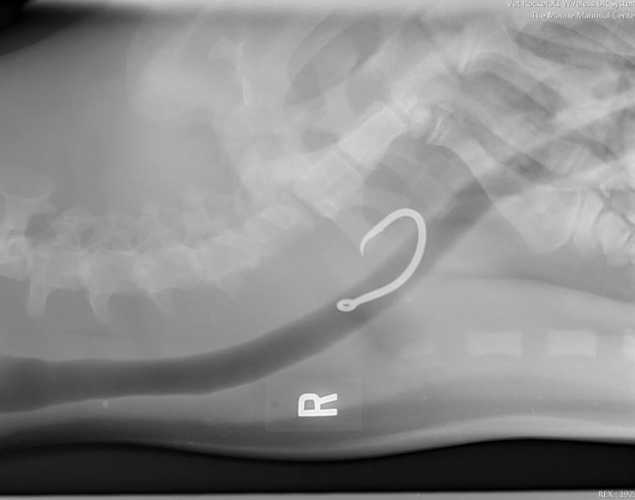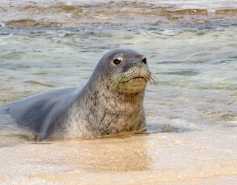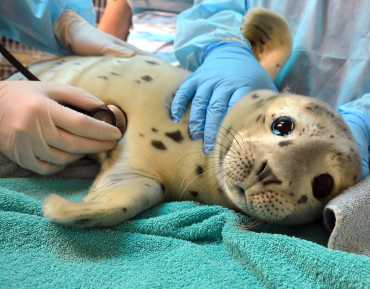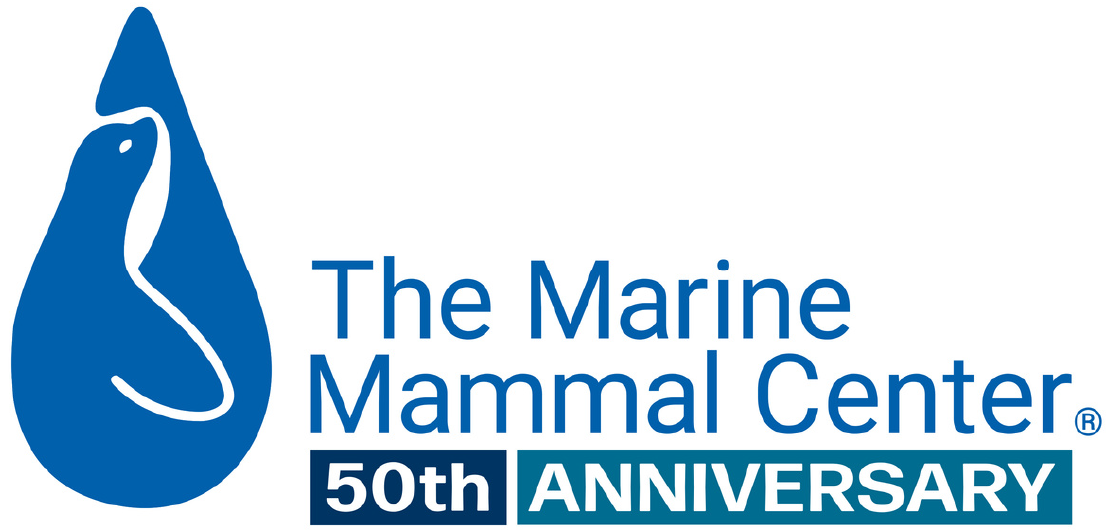
Emergency Surgery Saves Hooked Hawaiian Monk Seal
- Species conservation
- Entanglement
With just 1,100 Hawaiian monk seals alive in the wild today, every individual matters. That’s why an expert from The Marine Mammal Center leapt into action to save one of these critically endangered animals after it swallowed a fishing hook.
When Dr. Shawn Johnson got the call about a critically endangered Hawaiian monk seal in need of emergency surgery, he told the veterinarian on the other line that he’d be on the next plane. And he meant it.
Within hours, Dr. Johnson, the Director of Veterinary Science at The Marine Mammal Center, was en route from San Francisco to Honolulu. He arrived at noon local time and by 1 p.m., he was easing the seal into an anesthesia-fueled slumber.
The Hawaiian monk seal on the operating table was a young male known to researchers as RF28. He was rescued on a beach in Kauai after being spotted with fishing tackle near his mouth but no fishing line (or hook) present.
An X-ray of the animal’s throat and chest, taken with a portable Vet Rocket X-ray machine, had confirmed that the seal had ingested a large fishing hook, which had become embedded in the lining of his esophagus.
The veterinary team examining RF28, led by Dr. Gregg Levine and other experts from the NOAA Fisheries Hawaiian Monk Seal Research Program, knew that the ingested hook would be deadly if not removed. After stabilizing the sleeping seal, they moved quickly but carefully as they began the de-hooking procedure.
Hawaiian monk seals have a fairly tough esophagus because they are accustomed to swallowing fish whole, so the team was hopeful that they could remove the hook by pulling it out through the seal’s mouth rather than having to open his body cavity, a much riskier procedure.
Using an endoscope that allowed the team to see what they were doing inside the seal’s throat, they were able to snake a de-hooking tool down the esophagus to locate and dislodge the hook.
After several hours of delicate maneuvering, the two-inch hook was successfully removed. But the surgery—and the danger to the monk seal—wasn’t over yet.
One of the most dangerous parts of a major surgery like this is the anesthesia, and that is especially true for seal patients. These animals are adapted to life in the ocean, including the ability to dive deep and hold their breath for a long time. Without assistance, they may not breathe under anesthesia at all.
After receiving an initial dose of medication that will slow them down enough to be handled and then a special gas to start the anesthesia process, seals must be placed on a ventilator that will regulate their breathing. Just getting these animals intubated, or fitted with a tracheal tube, is no easy task.
Lucky for RF28, Dr. Johnson has had many years of surgical experience working with marine mammals, including a special fellowship in anesthesia. With Dr. Johnson’s help, RF28 woke up safely after his three-hour surgery.
After a few days of observation, RF28 was released back into the wild near the spot where he was rescued. He returned to a growing population of about 200 seals in the main Hawaiian Islands.
Learn More About Hawaiian Monk Seals
Sign up to receive Hawaiian monk seal news, patient updates and more straight to your inbox.
{"image":"\/Animals\/Wild\/Hawaiian monk seal\/hawaiian-monk-seal-shutterstock.jpg","alt":"Hawaiian monk seal at the shoreline","label":"Pinnipeds","title":"Hawaiian Monk Seal","link_url":"\/animal-care\/learn-about-marine-mammals\/pinnipeds\/hawaiian-monk-seal","type":"page"}

{"image":"\/Animals\/Wild\/Hawaiian monk seal\/cropped-images\/HMS-wild-NOAA-4-832-3197-1474-1603733454.jpg","alt":"Two Hawaiian monk seals sleeping on the beach.","label":"Conservation","title":"Hawaiian Monk Seal Conservation","link_url":"\/science-conservation\/conservation\/hawaiian-monk-seal-conservation","type":"page"}

{"image":"\/Animals\/Patients\/Hawaiian monk seals\/2015\/hms-pearl-by-julie-steelman-c-the-marine-mammal-center-noaa-permit-18786.jpg","alt":"Hawaiian monk seal Pearl","title":"Understanding Endangered","link_url":"https:\/\/www.marinemammalcenter.org\/publications\/understanding-endangered","label":"Online Learning Resource","type":"publication"}

{"image":"\/Animals\/Patients\/Hawaiian monk seals\/2016\/hms-nihoole-5-photo-c-noaa-permit-16632.jpg","alt":"Hawaiian monk seal Niho'ole","title":"Aloha \u02bb\u0100ina","link_url":"https:\/\/www.marinemammalcenter.org\/publications\/aloha-aina","label":"Online Learning Resource","type":"publication"}

Spotting Trouble in the Distance
Meanwhile, about 1,000 miles away in the middle of the Northwestern Hawaiian Islands, researchers have been monitoring a larger, but declining population of monk seals.
Researchers estimate that about 900 Hawaiian monk seals live on the atolls in this archipelago extending northwest from the main Hawaiian Islands. But fewer than one in five pups in this area survive their first year due to threats like entanglement in ocean trash, changes in the food chain and predation.
Dr. Michelle Barbieri, The Marine Mammal Center’s conservation medicine veterinarian based in Hawaii, and our Ke Kai Ola hospital operations manager, Deb Wickham, joined NOAA biologists on an extensive research trip to study these animals and provide life-saving medical care to sick, entangled or injured seals.
They’ve also been able to check up on the progress of previous patients, such as Mele and Pua, who were spotted looking healthy on beaches near where they were released earlier this year after spending several months rehabilitating at our Ke Kai Ola hospital on the island of Hawaii.
Says Dr. Johnson, “No matter the effort involved—whether it’s a three-hour surgery or a three-month rehabilitation process—every Hawaiian monk seal we save is a huge success story for this critically endangered species.”
Yes, I want to save a life!

Yes, I want to save a life!
You’ll be giving sick and injured animals the best possible care at the Center’s state-of-the-art hospital. With your gift today, you are giving a patient a second chance at life in the wild.
See Our Latest News
{"image":"\/Animals\/Patients\/Harbor seals\/2020\/cropped-images\/hs-barnwood-by-bill-hunnewell-c-the-marine-mammal-center-315-0-3299-2577-1607370547.jpg","alt":"harbor seal Barnwood","title":"Last-Minute Gift Guide \u2013 Top Gifts that Give Back to Marine Animals","link_url":"https:\/\/www.marinemammalcenter.org\/news\/last-minute-gift-guide","label":"News Update","date":"2025-12-18 01:00:00"}

Last-Minute Gift Guide – Top Gifts that Give Back to Marine Animals
December 18, 2025
Read More{"image":"\/Animals\/Patients\/Hawaiian monk seals\/2025\/cropped-images\/b-ru72admission-to-ke-kai-ola112125photo-c-the-marine-mammal-center-noaa-permit-24359-0-364-1270-992-1766095407.jpg","alt":"A newborn Hawaiian monk seal pup with a black coat in rehabilitative care.","title":"Newborn Hawaiian Monk Seal Pup Now Receiving Care","link_url":"https:\/\/www.marinemammalcenter.org\/news\/newborn-hawaiian-monk-seal-pup-now-receiving-care","label":"Patient Update","date":"2025-12-18 01:00:00"}

{"image":"\/Animals\/Patients\/Hawaiian monk seals\/2025\/cropped-images\/d-ru28release-exam-at-ke-kai-ola111025photo-by-giancarlo-rulli-c-the-marine-mammal-center-noaa-permit-24359-0-0-1270-992-1764620886.jpg","alt":"","title":"Bird Flu Vaccine Trial Offers Hope for Protecting Hawaiian Monk Seals","link_url":"https:\/\/www.marinemammalcenter.org\/news\/bird-flu-vaccine-trial-may-offer-hope-for-protecting-hawaiian-monk-seals","label":"News Update","date":"2025-12-01 08:13:00"}

Bird Flu Vaccine Trial Offers Hope for Protecting Hawaiian Monk Seals
December 1, 2025
Read More{"image":"\/Animals\/Patients\/Hawaiian monk seals\/2021\/hms-pp08-by-sheila-latta-c-the-marine-mammal-center-noaa-permit-18786.jpg","alt":"Hawaiian monk seal","title":"The New York Times: Inside the Bird-Flu Vaccine Trial for Monk Seals","link_url":"https:\/\/www.marinemammalcenter.org\/news\/the-new-york-times-inside-the-bird-flu-vaccine-trial-for-monk-seals","label":"In the News","date":"2025-12-01 01:00:00"}

The New York Times: Inside the Bird-Flu Vaccine Trial for Monk Seals
December 1, 2025
Read More

